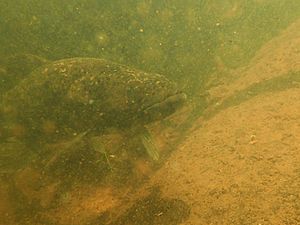Black wolf-fish facts for kids
Quick facts for kids Black wolf-fish |
|
|---|---|
 |
|
| Scientific classification |
The black wolf-fish, also known as Hoplias curupira, is a fascinating fish found in many parts of the Amazon basin. Even though it's been around for a long time, scientists only officially named and described it in 2009.
Contents
Discovering the Black Wolf-Fish
Scientists gave the black wolf-fish its official name, Hoplias curupira, in 2009. Two Brazilian zoologists, Osvaldo Takeshi Oyakawa and George Mendes Taliaferro Mattox, were the first to describe it. They found the first official specimen in the Rio Itacaiúas, a river in Brazil's Pará State.
The fish's name, curupira, comes from a cool Brazilian legend. Curupira is a mythical forest spirit. This spirit protects the forest and its animals. Sometimes, Curupira looks like a small Native American child. But here's the twist: its feet are turned backward! This makes it super hard for anyone to follow its tracks.
Where the Black Wolf-Fish Lives
The black wolf-fish lives across a large area in northern South America. You can find it in countries like Venezuela, Guyana, and Suriname. It's also common in Brazil.
This fish makes its home in several major river systems. These include the Orinoco River, the Rio Negro (Amazon) and its smaller streams, the Rio Tocantins, and the Rio Xingu.
Home Sweet Home: Black Wolf-Fish Habitat
Hoplias curupira prefers to live in big rivers. It also lives in smaller waterways called igarapés. These igarapés are like natural canals. They are often narrow streams that canoes can easily travel through.
What the Black Wolf-Fish Looks Like
The black wolf-fish is a medium-sized fish. It has a strong, bulky body compared to other fish in its family. It also has a blunt head and a wide body.
Its color can change depending on how it feels. It can go from a light brown pattern to almost solid black. This is why it's called the black wolf-fish! In aquariums, these fish usually grow to about 40 centimeters (about 16 inches) long. But in the wild, some have been seen as long as 75 centimeters (about 30 inches)!
Black Wolf-Fish Habits and Behavior
Like other fish in the Hoplias group, the black wolf-fish is a clever hunter. It's an ambush predator. This means it hides and waits quietly for its prey. Then, it suddenly attacks!
Its diet includes many things. It eats insects, insect larvae, small fish, and shrimp. It also enjoys worms and even some fruits. Unlike some of its relatives, the black wolf-fish is more active during the day. These fish often live in pairs. They work together to defend their home territory from other fish.
See also
 In Spanish: Hoplias curupira para niños
In Spanish: Hoplias curupira para niños

